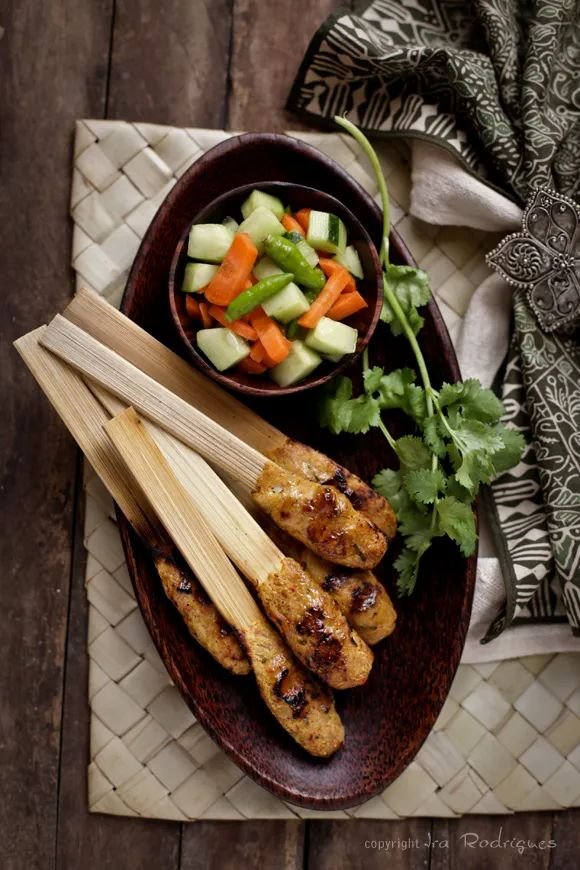Guest Post: Balinese Chicken Sate




I can’t emphasise enough how wonderful blogging is for connecting with foodie friends from all corners of the globe. One such gem is Ira, the talented mind behind Cooking Tackle. I’m truly glad to have stumbled upon her blog. Ira calls Bali, Indonesia home – one of the most breathtaking places I’ve ever visited.
A Journey with Cooking Tackle 📸🍲
Since she started blogging in 2008, Ira has been sharing a treasure trove of scrumptious recipes paired with stunning food photography. I’ve been an avid follower, always eagerly awaiting her next culinary creation. Today, I’m absolutely thrilled to have Ira join us, bringing a taste of Bali right to your screens. Let’s give a warm welcome to Ira!
A Warm Welcome from Ira 🙌
First off, I’d like to thank Leemei for the kind invitation to be a guest on My Cooking Hut. It’s an absolute honour to share a traditional Balinese dish with all of you.
I’m Ira, a fortunate soul living on the enchanting island of Bali, Indonesia. Bali’s natural beauty is unmatched, with its gentle oceans and majestic cliffs, making it a perfect place to relax and soak up life. But Bali isn’t just about its stunning landscapes; it also boasts a rich culinary heritage that’s simply irresistible.
Introducing Balinese Chicken Sate (Sate Lilit Ayam) 🍢🌿
Today, I’m excited to share a classic Balinese Chicken Sate recipe – Sate Lilit Ayam. These skewers of minced chicken are mixed with freshly grated coconut and infused with aromatic Balinese spices. Sate is deeply significant in Balinese culture, often featured in ceremonial offerings to the gods. It symbolises a mace, or "Gada," the powerful weapon of Dewa Brahmana, one of the Hindu Balinese gods.
The Essence of Balinese Cuisine 🌶️🌺
Bali is home to 13 distinct types of sate, each as diverse and colourful as the island’s culture. What I love most about Balinese food is the use of the freshest spices available – from vibrant turmeric to aromatic galangal, ginger, and lemongrass. These fresh ingredients give Balinese cuisine its signature spicy, exotic, and authentic flavour.
Prep Time: 20 minutes
Cook Time: 30 minutes
Yield: 17-18 sate
Ingredients:
200 chicken mince
1/3 cup cup fresh grated coconut
4 kaffir lime leaves, finely sliced
17 bamboo skewers or 17 stalks lemongrass
salt to taste
6 shallots
5 garlic cloves
5 red chillies
2 bird eye chillies
2 candle nuts, crushed and toasted
20g fresh kaempferia galanga (kencur), chopped
30gr fresh turmeric, chopped
40gr fresh galangal, chopped
3 kaffir lime leaves, torn
2 Indonesian bay leaves (daun salam)
1 lemongrass, bruised
½ tsp shrimp paste (terasi/belachan)
2 tbsp shaved coconut sugar, substitute palm sugar or brown sugar
Coconut oil or vegetable oil for frying
Method:
To make the spice paste:
1. Using mortar and pestle or food processor, combine all ingredients except lemongrass, kaffir lime leaves and salam leaves and grind to smooth paste. Add a bit of water of cooking oil if needed to help blending.
2. Heat the oil in a wok, add the spice paste, lemongrass, salam leaves, and kaffir lime leaves. Cook over medium heat, cook until the spice paste becomes fragrant or has changed colour to almost golden brown. Set aside
To make the sate:
1. Place the chicken mince in a big bowl, add fresh grated coconut and finely sliced kaffir lime leaves, mix well to combine. Add 2 tablespoons of spice paste, season with salt. Mix until the chicken has evenly coated with the spice paste.
2. Take a heaped tablespoon of the mixture, place it on your palm and spread gently using the spoon. Take a bamboo skewer and place it onto the mixture, mould the mixture and press lightly onto the skewer. You can use fresh lemongrass as a skewer if you want.
